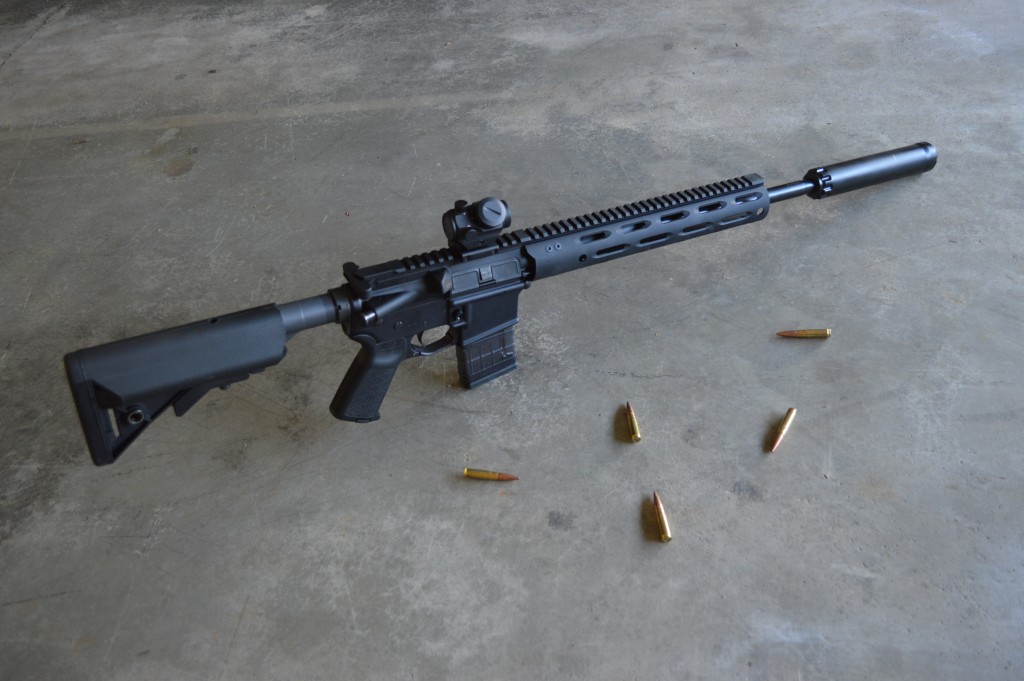The Best AR-15: Home Defense
June 5, 2013After publishing my response to Vice President Biden’s home defense advice, I have seen that many readers are finding my site while looking for the “best” AR-15 or the best rifle for their home defense needs. Because there seems to be some serious interest in this topic, let us take a closer look at why such questions can be difficult or impossible to answer.
Let me start out by saying that semi-automatic rifles, in general, make good personal defense weapons. Just as an AR can make a good home defense rifle, so too could an AK variant or any other of the numerous modern rifles on the market today. The reason that I tend to recommend the AR as a starting point for home defense lies primarily with the wide variety of accessories and ammunition that the AR-15 family of rifles can accept.
The obvious starting point for the debate over the best AR for personal defense is almost universally barrel length. At the risk of sounding hypocritical, a 16″ barrel or shorter (if NFA is an option in your state) is the way to go. Though I own and shoot nothing shorter than an 18″ barrel AR, lopping off a few more inches increases maneuverability and lightens the rifle. The shorter barrel will also lead to lower muzzle velocity, which in combination with some defensive loads, can help to reduce some (but not all) overpenetration. Because of the benefits offered by a shorter barrel, I would even go so far as to recommend a short-barreled rifle (SBR) for home defense, even in spite of the unique challenges presented by NFA firearms. A shorter barrel will also facilitate using a suppressor (if legal in your area) to help reduce some of the noise and concussion from firing, should a home invasion result in an escalation of force. Though I am no lawyer, I feel the benefits that come from using a suppressor and/or an SBR outweigh potential headaches of using NFA firearms for home defense.
After barrel length, optics make up another important consideration for a personal defense rifle. Because we cannot predetermine what sort of lighting will be available in the event of a home invasion, an illuminated optic or red dot is an excellent choice. For these purposes, the great battery life offered by Aimpoints or dual illumination of Trijicon optics are great choices. I would avoid a magnified optic for these purposes unless you have spent time training with it as consistent cheek weld becomes much more critical with magnified optics, and quick target acquisition can be more difficult through a magnified lens. At the lower end of the price spectrum, Primary Arms makes some excellent optics that hover around $100 and are backed by great customer service and an emphasis on quality. Regardless of optic choice, it is important to be able to shoot with both eyes open in order to maintain optimal situational awareness.
In addition to quality optics, home defense rifles should be equipped with a reliable flashlight. This is not only to aid in identifying the potential threat but also to disorient the invader if a break-in occurs at night. I cannot stress the importance of making sure you know what you are shooting at and what is beyond the target prior to pulling the trigger. Further, be sure to mount the light on the right side of the weapon if you are right-handed and the left side if your left hand is your primary side. This way, an armed intruder who may feel inclined to fire towards the light will not be firing directly at your center of mass.
Beyond these equipment recommendations, the options are pretty wide open. There simply is no single best AR-15 rifle on the market. The Knights Armament SR-15, Larue OBR/PredatAR, and LWRC lineup are all great high-end rifles and are accompanied by several other reliable and more affordable options in today’s market. As far as the actual brand or configuration is concerned, there are only a few things that I would see as “must-haves.” Though a home defense rifle should be kept clean, a chrome-lined or stainless barrel may me more reliable if the chamber becomes dirty or the ammunition is prone to sticking. This is of particular concern when using steel-cased ammunition (not recommended for self-defense). I would also recommend at least a mid-length gas system for any rifle with a barrel over 14″ long. The shorter dwell time and overall more voluminous gas system that the mid and rifle-length gas systems provide often leads to a softer shooting rifle. Lastly, for those who do not have considerable experience in building AR-type rifles, I recommend purchasing a complete rifle to start out with. This reduces the likelihood of potentially dangerous build mistakes and subsequent malfunctions.
I hope this helps some of you out there who might be on the fence about selecting an AR for home defense. With the litany of manufacturers offering hundreds of configurations, the choice can be quite difficult. However, with some preliminary guidelines, the decision can be made much more manageable and far less intimidating. With proper training and sufficient practice, nearly any AR can be a suitable self-defense tool. If any readers have questions about different brands, be sure to post in the comments, and I will help out as much as possible.
An information security professional by day and gun blogger by night, Nathan started his firearms journey at 16 years old as a collector of C&R rifles. These days, you’re likely to find him shooting something a bit more modern – and usually equipped with a suppressor – but his passion for firearms with military heritage has never waned. Over the last five years, Nathan has written about a variety of firearms topics, including Second Amendment politics and gun and gear reviews. When he isn’t shooting or writing, Nathan nerds out over computers, 3D printing, and Star Wars.

